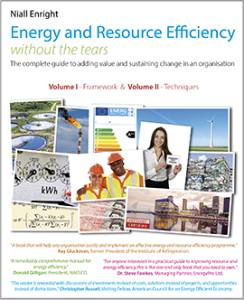Maturity Matrices
Our mission
To deliver outstanding results for customers and support best practices in our profession.
Energy and Resource Efficiency without the tears
Niall Enright’s book was published in June 2017 and last updated in September 2018.
To get the FREE PDF visit the download page.
4781 Downloads |
To buy a print version of the book or order the companion files please visit our store.
If you appreciate the book and want to make a donation towards the publication costs (and support future publications), click the link below. This is entirely optional!
Free Lighting Hours Tool
We were so frustrated at SustainSuccess with trying to find daylight hour tables for client locations that we wrote our own Excel/Google Maps/NOAA “mashup” to calculate lighting hours for any location on Earth! We are providing it FREE to fellow practitioners. Simply fill in this form and we’ll send you a download link.
1373 Downloads |
Ideas and Challenges
Despite self-congratulatory case studies to the contrary, the reality is that Sustainability and Resource Efficiency are NOT EASY to implement successfully in organisations.
In a series of blogs, articles, book reviews, and extracts from Niall Enright's book you will find hints, tips and suggestions to make Sustainability a Success.
Connect
Contact SustainSuccess
F: +44 161 969 1361 E: mail@sustainsuccess.co.uk
A:19 Harboro Road
Sale
M33 5AF, UK
To send me an email, simply click here, or complete the contact form.
For full contact details in internet format vCard click here or scan the QR code below.

Search
Posts, Articles and Reviews
| M | T | W | T | F | S | S |
|---|---|---|---|---|---|---|
| 1 | 2 | 3 | 4 | |||
| 5 | 6 | 7 | 8 | 9 | 10 | 11 |
| 12 | 13 | 14 | 15 | 16 | 17 | 18 |
| 19 | 20 | 21 | 22 | 23 | 24 | 25 |
| 26 | 27 | 28 | 29 | 30 | 31 | |
Archive
Useful Sites
Here are some of my favourite energy and resource efficiency sites (mouse over the names for more details).
Resources:- Bizee Degree Days
- Europe's Energy Portal
- Efficiency policies and measures
- IEA CO2 Emissions Data
- Carbon Trust - guides
- WRAP and Envirowise
- UK Association for the Conservation of Energy
- Institute for Building Efficiency
- The Keeling Curve - CO2 level
- DECC My2050
Blogs:
- Energy pathfinder
- Only Eleven Percent
- Smart Energy Efficiency
- The Cokatoo Chronicles
- Alan's Energy Blog
- The Bustard
- The Energy Collective
- House 2.0
Collaborators:

